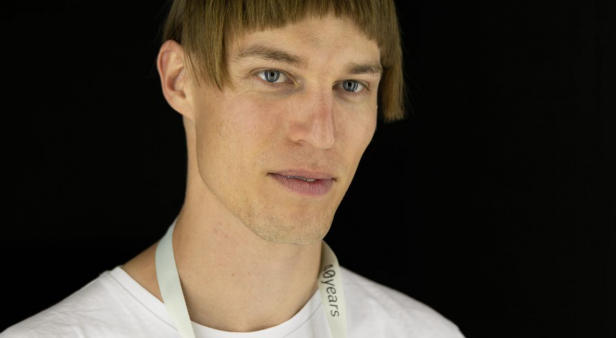To start, we’d love to go back to the start of your career. When did you first discover your artistic voice and urge to create?
For a long time, I didn’t consider myself an artist, I wasn’t totally sure why I was making things. I’ve been interested in robotics and technology for as long as I can remember, but art came much later. I guess when I was a teenager the maker movement was a big thing, at least to me, so I started building 3D printers and became involved in online open source communities. I wrote guides too, though my work never strictly aligned with the maker movement – I wrote things like how to hack automated street signs and build tattoo guns. Things you probably shouldn’t write guides for.
Your career has seen you work across kinetic/new media formats, including robotics! What is the allure of using robotics as a form of expression?
I have a somewhat dissonant relationship with technology, particularly digital tech and the way things are going. I believe that physical, tangible experiences with technology are a course for healthier relationships with space and environment. It connects people to the here and now, rather than a cloud of data beyond our reality.
Artists that dabble in painting and sculpture spend years practicing their craft, but robotics and technology-based media would require a vastly different set of skills and access to different materials. In the beginning, what did you have to learn to become proficient enough to do justice to your ideas?
“Proficient enough” is a good way to phrase it! I am often curious what an engineer would think when they see my work (laughs). I work within a known skillset, things I’ve learned from taking things apart, or information I’ve found online. If you want to learn how something does what it does, the best thing you can do is break things and get your hands on the gizzards that make ‘em work.
Much of your art examines technology and its impact on/place within our ecology and society. Would you say your use of technology in your art portrays it as a favourable or beneficial facet of our society, or do these works stand as a cautionary tale of the dangers of technological advancement?
Technology provides the perfect vehicle for deconstructing the very problems that it creates. I guess it’s akin to the approach of breaking things to learn about them. Modern technology is little more than an amalgamation of the stolen ingenuity of nature and hyper-capitalist ideals.
Your work ‘Little Sunfish’ features in QAGOMA’s incredible exhibition Water. It touches on the inadvertent impacts of tech on our environment, but also the evolution of machines into something more – something with some form of thought and autonomy. Can you break down what initially inspired this piece?
I was invited to propose a piece for the GOMA Water exhibition. I landed on several ideas, but one tangent took hold. Water was the root cause of the Fukushima nuclear disaster and continues to be a problem to this day. Tokyo Electric Power Company (TEPCO) has frozen the earth solid around the reactors in an effort to stop irradiated water seeping into groundwater. In this effort, they continue to pump tons of tritiated cooling water into reservoirs around the site.
The disaster is unprecedented, and unlike the Chernobyl incident which used Bio-Robots (Soviets) to decontaminate the site, they are using real robots. And this, nonetheless, presents a harrowing tale. When I began researching the project, TEPCO had already lost 17 inspection and decontamination robots in the facility. Little Sunfish was the first successful investigation of Reactor 3’s PCV which remains completely flooded. The Little Sunfish explored the interior of the building and found radioactive debris during its multi-day mission. Once extracted, the Little Sunfish would be too irradiated for maintenance, and so its life and service are likely over anyway.
My work ‘Little Sunfish’ 2019 at GOMA presents a fictional narrative in which the robot becomes untethered in the reactor and slowly dies. The robot returns in some sort of sentient-zombie form when it absorbs a dose of radiation, powering it through the rest of the narrative in which it escapes into the ocean and streams. In this way Little Sunfish becomes a vehicle for the irradiated water, making its way back into the ocean.
This work, and some of your earlier pieces, are incredibly complex – how long does it usually take for you to complete a piece? We’d assume there are a lot of moving parts at play …
‘Little Sunfish’ 2019 took over a year to complete, the submarine itself was 3D modelled using images of the original inspection robot than 3D printed. The submarines built to use in the film fit in the palm of your hand, while the original used in the reactor is about 30cm long. I built smaller ones so that the submarines could manoeuvre through the tiny scale sets submerged in a fish tank. Several units were created with different capabilities for the different environments and scenes, some could go in saltwater, some were remotely operated, some were autonomous, and almost all recorded video. At one point I even built a flying unit for the scene in the video work where Little Sunfish shoots skyward upstream a waterfall, but in the end I used a submerged air cannon to launch one of the other Little Sunfish submarines up the waterfall.
I love working with video. It’s an amazing way to share special moments and stories that can’t always happen in front of you. For this reason, I use hardly any post production when I shoot, all the scenes have to actually happen to remain authentic. So yes, Little Sunfish really did get eaten by a cuttlefish, and I had no idea that was going to happen! Currently I am working through the files and development to produce an open-source document for building your own Little Sunfish. My gallerist probably won’t be happy about that though …
Is there anything that you’re most proud of that you’ve achieved so far, and what is the next goal you are striving towards?
I am currently undertaking my Masters at Cranbrook Academy of Art in Detroit, Michigan – it’s something I have considered for a little while now and I’m pretty glad I finally took the leap. So far it’s been an amazing experience, and the format of their programs provides exactly the right forum for developing new and provocative ideas. I’m excited to share more soon!
Michael’s work ‘Little Sunfish’ forms part of GOMA’s current exhibition Water, which is running until Sunday April 26.

